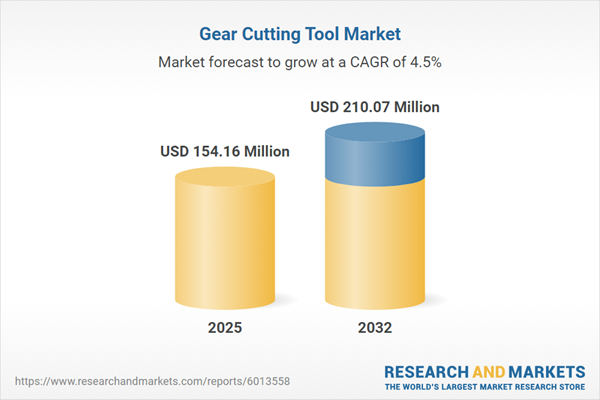Speak directly to the analyst to clarify any post sales queries you may have.
The gear cutting tool market is undergoing significant transformation, driven by evolving manufacturing demands for greater precision, efficiency, and advanced digital integration. This industry is strategically positioned at the core of global industrial supply chains, reflecting both complex technical requirements and rapid innovation cycles.
Market Snapshot: Gear Cutting Tool Market Overview
The Gear Cutting Tool Market grew from USD 147.61 million in 2024 to USD 154.16 million in 2025. It is expected to continue growing at a CAGR of 4.50%, reaching USD 210.07 million by 2032. This trajectory is sustained by increased demand from automotive, aerospace, energy, and heavy machinery sectors, alongside shifts in manufacturing practices and the broader adoption of digital manufacturing technologies. The market’s expansion highlights the critical role gear cutting tools play in equipment longevity, operational reliability, and competitive differentiation for manufacturers worldwide.
Scope & Segmentation
This report provides comprehensive coverage across all core segments shaping the gear cutting tool landscape:
- Gear Cutting Method: Broaching; Grinding; Hobbing; Honing; Milling; Shaping; Shaving.
- Machine Type: CNC (Five Axis, Four Axis, Three Axis); Conventional.
- Application: Bevel Gears; Gear Racks; Helical Gears; Internal Gears; Spur Gears; Worm Gears.
- End Use Industry: Aerospace (Civil, Military); Automotive (Commercial Vehicles, Passenger Vehicles); Energy and Power; Heavy Machinery.
- Material: Cast Iron; Non-Ferrous Metals; Plastics; Steel.
- Sales Channel: Direct; Distributor (Industrial, Specialty); Online.
- Geography: Americas (United States, Canada, Mexico, Brazil, Argentina, Chile, Colombia, Peru); Europe, Middle East & Africa (United Kingdom, Germany, France, Russia, Italy, Spain, Netherlands, Sweden, Poland, Switzerland, United Arab Emirates, Saudi Arabia, Qatar, Turkey, Israel, South Africa, Nigeria, Egypt, Kenya); Asia-Pacific (China, India, Japan, Australia, South Korea, Indonesia, Thailand, Malaysia, Singapore, Taiwan).
- Companies: Analysis includes The Gleason Corporation, Klingelnberg GmbH, Liebherr-Verzahntechnik GmbH, KAPP NILES GmbH & Co. KG, Reishauer AG, EMAG GmbH & Co. KG, Mitsubishi Heavy Industries, Ltd., Kennametal Inc., Sandvik AB, and Seco Tools AB.
Key Takeaways: Strategic Insights for Decision-Makers
- The gear cutting tool sector is evolving via technological advancements such as automation, digital twins, and predictive maintenance, enabling manufacturers to achieve higher productivity and quality.
- Market segmentation based on application, end-use, and materials ensures that industry participants can target solutions to each sector’s unique performance and compliance requirements.
- Sustainable manufacturing, including the adoption of eco-friendly coatings and cooling methods, is becoming a strategic imperative for manufacturers seeking both profitability and regulatory compliance.
- Supply chain resilience, through dual-sourcing and nearshoring, is rising in importance, especially as policy and logistics disruptions create new risks and opportunities.
- Integrated service offerings, such as reconditioning and remote diagnostics, build customer loyalty and provide competitive differentiation.
Tariff Impact: 2025 Policy Shifts and Industry Response
Recent United States tariffs have reshaped supply chain calculations. Companies are mitigating higher landed costs by diversifying vendors, expanding domestic operations, and prioritizing lean inventory management. These efforts help secure margin stability despite increased duties, and highlight the importance of agile sourcing and transparent logistics within the gear cutting tool industry.
Methodology & Data Sources
This research integrates qualitative and quantitative analysis, including secondary sources such as technical publications, industry journals, and patent filings, as well as primary insights from stakeholder interviews. Triangulation and peer validation form the backbone of data integrity, ensuring each insight is credible and actionable.
Why This Report Matters for Senior Decision-Makers
- Offers strategic clarity on emerging trends, segmentation shifts, and regional growth opportunities to support effective capital allocation.
- Delivers actionable insight on supply chain adaptation and sustainability practices essential for long-term competitiveness and compliance.
Conclusion
The gear cutting tool market is set for sustained growth amid rising technological sophistication and evolving supply chain dynamics. Strategic investment in innovation, resilience, and customer-centric offerings will position companies for lasting success in this critical industrial domain.
Additional Product Information:
- Purchase of this report includes 1 year online access with quarterly updates.
- This report can be updated on request. Please contact our Customer Experience team using the Ask a Question widget on our website.
Table of Contents
3. Executive Summary
4. Market Overview
7. Cumulative Impact of Artificial Intelligence 2025
Companies Mentioned
The companies profiled in this Gear Cutting Tool market report include:- The Gleason Corporation
- Klingelnberg GmbH
- Liebherr-Verzahntechnik GmbH
- KAPP NILES GmbH & Co. KG
- Reishauer AG
- EMAG GmbH & Co. KG
- Mitsubishi Heavy Industries, Ltd.
- Kennametal Inc.
- Sandvik AB
- Seco Tools AB
Table Information
| Report Attribute | Details |
|---|---|
| No. of Pages | 189 |
| Published | October 2025 |
| Forecast Period | 2025 - 2032 |
| Estimated Market Value ( USD | $ 154.16 Million |
| Forecasted Market Value ( USD | $ 210.07 Million |
| Compound Annual Growth Rate | 4.5% |
| Regions Covered | Global |
| No. of Companies Mentioned | 11 |









